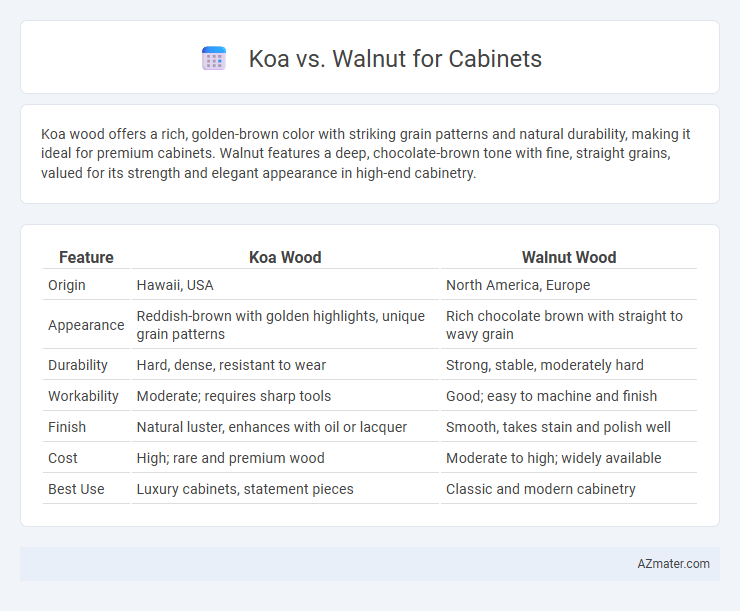Koa wood offers a rich, golden-brown color with striking grain patterns and natural durability, making it ideal for premium cabinets. Walnut features a deep, chocolate-brown tone with fine, straight grains, valued for its strength and elegant appearance in high-end cabinetry.
Table of Comparison
| Feature | Koa Wood | Walnut Wood |
|---|---|---|
| Origin | Hawaii, USA | North America, Europe |
| Appearance | Reddish-brown with golden highlights, unique grain patterns | Rich chocolate brown with straight to wavy grain |
| Durability | Hard, dense, resistant to wear | Strong, stable, moderately hard |
| Workability | Moderate; requires sharp tools | Good; easy to machine and finish |
| Finish | Natural luster, enhances with oil or lacquer | Smooth, takes stain and polish well |
| Cost | High; rare and premium wood | Moderate to high; widely available |
| Best Use | Luxury cabinets, statement pieces | Classic and modern cabinetry |
Introduction to Koa and Walnut Wood
Koa wood, native to Hawaii, is prized for its rich, warm tones and striking grain patterns, making it a premium choice for cabinetry with natural beauty and durability. Walnut wood, primarily sourced from North America, offers a dark, elegant appearance with fine, straight grains that provide a sophisticated look and excellent strength for long-lasting cabinets. Both woods are favored in high-end cabinetry for their unique aesthetics and resilient properties, catering to different design preferences and functional needs.
Origin and Availability of Koa and Walnut
Koa wood, native exclusively to Hawaii, is prized for its rich color and unique grain patterns, but its limited geographical origin restricts availability and often increases cost. Walnut, primarily sourced from the eastern United States and parts of Europe, is more widely available and sustainable due to extensive forestry management practices. The geographic distribution of walnut makes it a more accessible choice for cabinet manufacturing compared to the rare and region-specific koa.
Color and Grain Characteristics
Koa wood features a rich, warm color palette ranging from golden brown to deep amber, with striking curly and figured grain patterns that create dynamic visual interest for cabinetry. Walnut offers a more consistent dark brown hue with subtle purples or chocolates and a straight, fine grain that delivers a sleek, elegant appearance. Cabinetry crafted from koa emphasizes vibrant contrast and unique patterns, while walnut provides a classic, uniform look prized for its sophistication and durability.
Durability and Strength Comparison
Koa wood offers exceptional durability and strength, making it ideal for high-quality cabinetry with its dense grain and resistance to wear. Walnut is also strong and durable but tends to be slightly less dense than Koa, providing good sturdiness while offering a smoother finish. Both woods are premium choices, but Koa's superior hardness gives it an edge in long-term cabinet durability.
Workability and Machining Properties
Koa wood offers excellent workability with a fine, even texture and moderate hardness, allowing smooth cutting and shaping while minimizing tool wear. Walnut, known for its stable grain and moderate density, machines cleanly with minimal chipping or dulling, making it ideal for detailed cabinetry work. Both woods respond well to hand and power tools, but Koa's slightly higher oil content can enhance finishing but may require careful machining to avoid gum buildup.
Cost and Value Considerations
Koa cabinets typically command higher prices due to the wood's rarity and premium aesthetic, making them a luxury choice for upscale interiors. Walnut offers a more affordable option with excellent durability and a rich, warm tone that adds timeless value to cabinetry. Choosing between Koa and Walnut ultimately depends on budget constraints and desired investment in visual appeal and long-term satisfaction.
Sustainability and Environmental Impact
Koa wood, primarily sourced from Hawaii, is prized for its rapid growth compared to traditional hardwoods, making it a more sustainable choice due to its faster replenishment rate. Walnut, while durable and aesthetically appealing, typically comes from slower-growing trees, leading to higher environmental impact and less sustainable harvesting practices. Choosing Koa for cabinets supports sustainable forestry efforts, reduces deforestation risks, and minimizes carbon footprint compared to the often less eco-friendly walnut options.
Best Uses in Cabinetry
Koa wood offers a striking grain and rich, warm hues, making it ideal for high-end custom cabinetry where aesthetics are paramount, such as in luxury kitchens and statement furniture pieces. Walnut, known for its durability and smooth finish, excels in functional cabinetry applications that require strength and resistance to wear, like cabinet frames and frequently used storage areas. Both woods perform well in cabinetry but choosing Koa emphasizes visual appeal, while Walnut prioritizes robustness and longevity.
Maintenance and Care Requirements
Koa cabinets require regular dusting and occasional polishing with a wood conditioner to maintain their rich, glossy finish and prevent drying or cracking. Walnut cabinets need consistent cleaning with a mild soap solution and periodic application of a protective oil or wax to preserve their smooth texture and deep color. Both woods benefit from avoiding excessive moisture and direct sunlight to ensure long-lasting durability and appearance.
Choosing Between Koa and Walnut for Cabinets
Koa wood offers a striking grain pattern with warm golden to reddish hues, making it ideal for cabinets seeking a distinctive, tropical aesthetic. Walnut provides a rich, dark brown color with tight, straight grains, favored for its durability and classic, elegant appeal in cabinetry. Choosing between Koa and Walnut depends on the desired visual impact and budget, as Koa is typically more exotic and expensive, while Walnut balances luxurious appearance with more accessible availability.

Infographic: Koa vs Walnut for Cabinet
 azmater.com
azmater.com